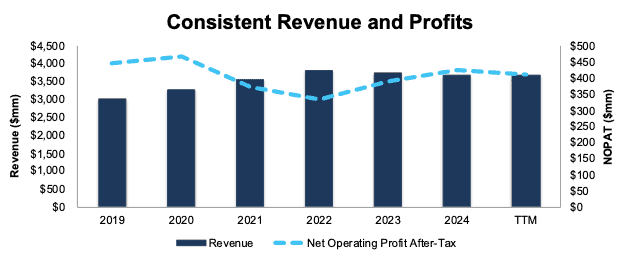Generating positive free cash flow is not always a good thing. Too often, firms allocate surplus cash toward outsized executive compensation packages or costly acquisitions that destroy shareholder value.
Keurig Dr Pepper Inc. (KDP) just announced an $18 billion acquisition of European coffee group JDE Peet’s. The market’s reaction was swift and negative, with KDP falling more than 16% since the announcement. Cleary, investors disagree with the strategic rationale and financial prudence of this deal.
Rather than overspending on an acquisition, companies can better serve their investors by returning excess cash to shareholders through dividends or share repurchases.
Our Safest Dividend Yields Model Portfolio only includes companies that generate sufficient cash flows to support dividend payments and stocks that earn our Attractive or Very Attractive rating. In other words, the stocks in this model portfolio give you the best of both worlds: safety and upside potential.
Below you will find a free stock pick from the latest edition of our Safest Dividend Yields Model Portfolio. This summary is not a full Long Idea report, but it will give you insight into the rigor of our research and approach to picking stocks.
Feel free to share this report with friends and colleagues.
We update this Model Portfolio monthly. August’s Safest Dividend Yields Model Portfolio was updated and published for clients on August 21, 2025.
Free Stock Pick: Reynolds Consumer Products (REYN: $23/share)
Reynolds Consumer Products (REYN) is the featured stock in August’s Safest Dividend Yields Model Portfolio.
Reynolds Consumer Products has grown revenue 4% compounded annually and generated more than $300 million in net operating profit after tax (NOPAT) each year since 2019. Since 2021, Reynolds Consumer Products has grown NOPAT 3% compounded annually. The company’s invested capital turns rose from 0.8 in 2021 to 0.9 in the TTM, while its NOPAT margin improved from 10.5% to 11.2% over the same time. Rising margins and invested capital turns drive the company’s return on invested capital (ROIC) from 8.7% in 2021 to 9.6% in the TTM.
Figure 1: Reynolds Consumer Products’ Revenue & NOPAT Since 2019
Sources: New Constructs, LLC and company filings
Free Cash Flow Exceeds Regular Dividend Payments
Reynolds Consumer Products has increased its regular dividend from $0.22/share in 3Q20 to $0.23/share in 3Q25. The current quarterly dividend, when annualized provides a 4.0% dividend yield.
The company’s free cash flow (FCF) easily exceeds its regular dividend payments. From 2020 through the first half of 2025 (1H25), the company generated $1.7 billion (24% of current enterprise value) in FCF while paying $988 million in regular dividends. See Figure 2.
Figure 2: Reynolds Consumer Products’ FCF Vs. Regular Dividends Since 2020
Sources: New Constructs, LLC and company filings
As Figure 2 shows, this company’s dividends are backed by a history of reliable cash flows. Dividends from companies with low or negative FCF are less dependable since the company might not be able to sustain paying dividends.
REYN Is Undervalued
At its current price of $23/share, REYN has a price-to-economic book value (PEBV) ratio of 1.0. This ratio means the market expects the company’s NOPAT to never grow from TTM levels. This expectation seems overly pessimistic given that the company has grown NOPAT by 3% compounded annually since 2021.
Even if the company’s:
- NOPAT margin immediately falls to 10% (equal to second lowest margin ever compared to 11% in the TTM) through 2034, and
- revenue grows just 2% (below CAGR of 4% over the last five years) compounded annually through 2034, then
the stock would be worth $28/share today – a 22% upside. In this scenario, the company’s NOPAT would grow just 1% compounded annually through 2034. Contact us for the math behind this reverse DCF scenario.
Should the company’s NOPAT grow more in line with recent growth rates, the stock has even more upside.
Critical Details Found in Financial Filings by Our Robo-Analyst Technology
Below are specifics on the adjustments we make based on Robo-Analyst findings in this featured stock’s 10-K and 10-Qs:
Income Statement: we made over $100 million in adjustments with a net effect of removing just under $75 million in non-operating expenses. Professional members can see all adjustments made to the company’s income statement on the GAAP Reconciliation tab on the Ratings page on our website.
Balance Sheet: we made over $50 million in adjustments to calculate invested capital with a net decrease of just over $25 million. One of the most notable adjustments was for accumulated other comprehensive income. Professional members can see all adjustments made to the company’s balance sheet on the GAAP Reconciliation tab on the Ratings page on our website.
Valuation: we made over $2 billion in adjustments, all of which decreased shareholder value. Apart from total debt, the most notable adjustment to shareholder value was for deferred tax liabilities. Professional members can see all adjustments to the company’s valuation on the GAAP Reconciliation tab on the Ratings page on our website.
This article was originally published on August 28, 2025.
Disclosure: David Trainer, Kyle Guske II, and Hakan Salt receive no compensation to write about any specific stock, style, or theme.
Questions on this report or others? Join our online community and connect with us directly.


